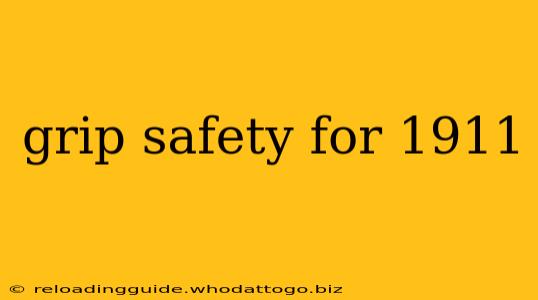The 1911 pistol, a legendary firearm, has seen numerous modifications and upgrades throughout its history. One area of frequent customization and debate centers around the grip safety. This guide delves into the intricacies of 1911 grip safeties, exploring their function, various designs, and the considerations involved in choosing the right one for your needs.
Understanding the 1911 Grip Safety's Role
The grip safety, located on the backstrap of the 1911, acts as a passive safety mechanism. It prevents the pistol from firing unless the grip safety is depressed, usually by the shooter's hand. This design is intended to enhance safety by preventing accidental discharges when the gun is carried or handled improperly. However, its effectiveness and user experience vary depending on the design and the individual shooter.
How the Grip Safety Works
When the pistol is held in a firing grip, the web of the shooter's hand naturally depresses the grip safety, allowing the trigger to function. When the pistol is not being held in a firing grip, the grip safety remains un-depressed and blocks the trigger's movement. This simple yet crucial mechanism forms part of the 1911's overall safety system.
Types of 1911 Grip Safeties
Several variations exist, each with its own advantages and drawbacks:
1. Standard Grip Safety
This is the most common type, featuring a relatively simple design. It's generally reliable and provides a straightforward safety function. However, some shooters find the standard grip safety can be slightly uncomfortable or interfere with their grip.
2. Extended Grip Safety
This design extends the grip safety's surface area, providing a more comfortable and positive engagement for many shooters. The larger surface makes it easier to depress consistently, which is particularly beneficial for those with smaller hands or those who prefer a higher grip.
3. Beavertail Grip Safety
A Beavertail grip safety extends further back than the standard, covering more of the backstrap and often incorporating an extended tang. This design offers improved comfort, especially for shooters with larger hands, and it can help prevent hammer bite – a painful pinch of the web of the hand by the hammer during recoil.
4. Grip Safeties with a Paddle
Some grip safeties incorporate a small paddle-like extension that can help with easier engagement. While some appreciate this extra leverage, others find it unnecessary or even bothersome.
5. Ambidextrous Grip Safeties
While less common than other variations, ambidextrous grip safeties are designed to be operated effectively by both left and right-handed shooters. This feature is beneficial for those who are ambidextrous or who switch shooting hands frequently.
Choosing the Right Grip Safety for You
Selecting the right grip safety is crucial for both safety and comfort. Consider these factors:
- Hand Size: Larger hands may benefit from extended or Beavertail grip safeties, while smaller hands might prefer a standard design.
- Shooting Style: Your shooting style and grip will influence which grip safety best suits your needs.
- Comfort: Ultimately, the grip safety should feel comfortable and allow for a natural, secure grip.
- Reliability: Ensure the grip safety is from a reputable manufacturer known for producing quality parts.
Installation and Considerations
Installing a new grip safety often requires a gunsmith’s expertise. Improper installation can compromise the firearm's function and safety. If you're not experienced with 1911 maintenance and modification, consult a qualified professional.
Conclusion
The 1911 grip safety is an integral part of the pistol's safety mechanism, and choosing the right one is crucial for optimal performance and comfort. By understanding the various types and considering your individual needs, you can enhance your 1911 shooting experience. Remember that safety always comes first, and consulting with experienced gunsmiths for installation and maintenance is highly recommended.

